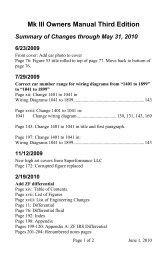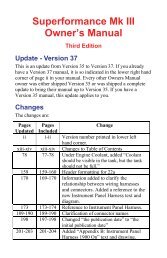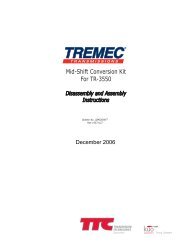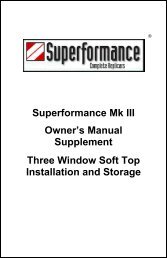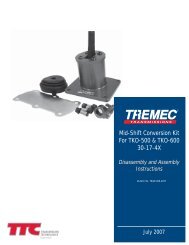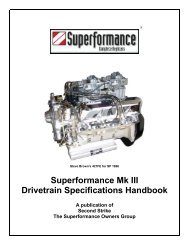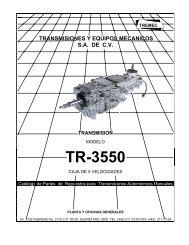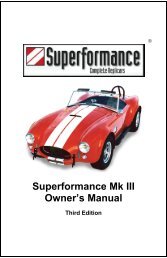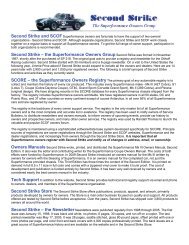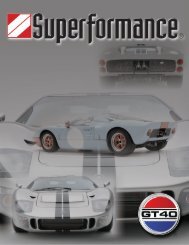Carburetor Calculator - Second Strike
Carburetor Calculator - Second Strike
Carburetor Calculator - Second Strike
You also want an ePaper? Increase the reach of your titles
YUMPU automatically turns print PDFs into web optimized ePapers that Google loves.
<strong>Second</strong> <strong>Strike</strong> Page 7<br />
The Newsletter for the Superformance Owners Group January 17, 2008 / September 5, 2011<br />
more power because each cylinder is running at the correct<br />
a pressure drop of 5%. A 750 will have 3.8% and an 850 will<br />
mixture. The more precise metering and better atomization<br />
have 2.9%.<br />
result in better low speed drivability and full throttle mid<br />
range power.<br />
The engine in this Holley dyno test is a 402 CID Chevrolet<br />
L34 producing 325 horsepower at 5000 rpm. The airflow at<br />
peak horsepower is 407 cfm. The somewhat oversized 650<br />
produced significantly more torque than the considerably<br />
oversized 800 all the way to the 5000 rpm power peak.<br />
Nowhere did the oversized 800 out pull the smaller 650.<br />
Figure 3: Pressure Drop<br />
Bigger is always bigger, but not always better.<br />
<strong>Carburetor</strong> Ratings<br />
<strong>Carburetor</strong>s are rated by airflow expressed in cubic feet per<br />
minute at a specified pressure drop. After evaluating the<br />
performance considerations over the entire airflow range, the<br />
carburetor sizing standards have been established to provide a<br />
balance of performance across the entire engine operating<br />
range.<br />
Two-barrels and four-barrels are rated differently. The<br />
difference is that two-barrels only have primaries and<br />
four-barrels are progressive, running on the primaries at low<br />
speed and the primaries and secondaries at high speed.<br />
Two-barrel carburetors are typically rated in cfm at a 10%<br />
pressure drop.<br />
Four-barrel carburetors are rated in cfm at a 5% pressure<br />
drop.<br />
A two-barrel cfm rating can be converted to the equivalent<br />
four-barrel rating by multiplying it by 0.707.<br />
The rated airflow is not a hard limit. As shown in Figure 3 for<br />
a 650, 750, and 850, a carburetor will pass more airflow at a<br />
higher pressure drop and less at a lower pressure drop. At a<br />
given airflow, the carburetor with the higher rating will have a<br />
lower pressure drop. For example, at 650 cfm, a 650 will have<br />
Figure 4: Low Speed Pressure Drop<br />
Low speed operation is also a consideration. In Figure 4,<br />
consider a “small car with a large engine” that needs about 12<br />
cfm of airflow to cruise at 50 mph in fifth gear. A 650 has a<br />
pressure drop of 0.0017% at that speed. At 12 cfm a 750 has a<br />
pressure drop of 0.0013%, a 25% loss in flow velocity and a<br />
41 % drop in metering signal. An 850 has a pressure drop of<br />
0.0010%, a 40% loss in flow velocity and a 65% drop in<br />
metering signal.<br />
Looking at it another way, if the 650 cruises comfortably at<br />
1575 rpm, the 750 would have to cruise 1850 rpm to get the



